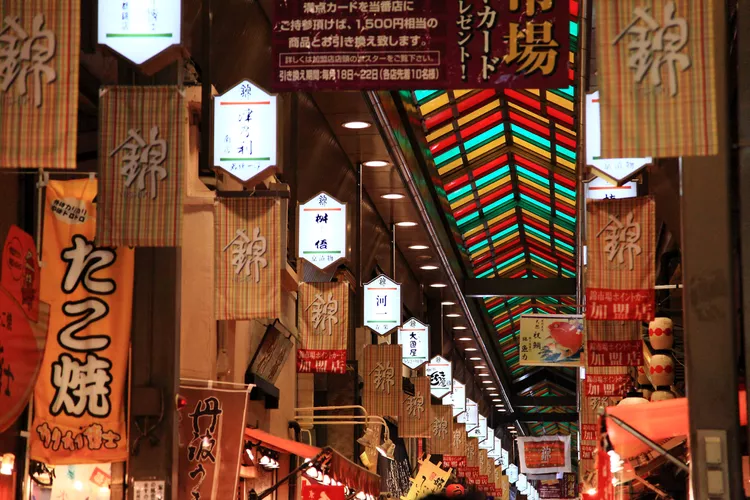Summary
Snacking on the go is generally frowned upon in Japan, a fact that might disappoint travelers seeking authentic culinary experiences at small stalls and food carts. The strict rules of Japanese etiquette forbid eating and walking simultaneously, which contributes to a less widespread street food culture compared to other Asian regions.
However, these rules don’t seem to apply at Kyoto’s Nishiki Market. Fondly referred to as “Kyoto’s kitchen,” this market features a diverse assortment of 150 shops, groceries, and stalls. Here, eating while walking is not only accepted but actively encouraged. Upon entering from its western entrance near Shijo Karasuma station, you’ll be greeted by a variety of delicious snacks-on-sticks, such as fried chicken, fish cakes, fresh sashimi, and tiny octopuses. Other tempting treats include sesame dumplings, yuzu honey ice cream, Japanese omelets, wagashi (traditional sweets), and soy powder-coated peanuts.
The Origins of Kyoto’s Kitchen
Nishiki Market may resemble other covered shopping arcades across Japan, but its reputation for offering only the highest quality goods has earned it a distinguished place among Japanese chefs. Aritsugu, a 450-year-old establishment that once crafted swords for royalty, now serves as one of Japan’s premier kitchen knife shops. The market also provides essential ingredients for Kyoto cuisine, such as Kyo yasai (traditional Kyoto vegetables), tsukemono (pickles), dried bonito, yuba (tofu skin), konyak, and miso. Both kaiseki masters and modern food enthusiasts make frequent pilgrimages to Nishiki, often arriving in the early morning, well before the crowds fill the narrow pedestrian pathways.
The market has existed since 1310 when a resourceful fish seller set up shop next to a neighboring spring. Other vendors soon followed, drawn by the opportunity to use the spring’s cool water to preserve seafood and other perishable goods. Today, Nishiki Market displays a dynamic personality that reflects a blend of its original identity as Kyoto’s local grocer and its newer identity as a tourist-friendly food hall. The market exudes liveliness yet can appear somewhat aloof; free samples of sweets, pickles, and rice crackers are abundant, and many shops are staffed by enthusiastic young salespeople promoting their goods. Conversely, some vegetable and fish vendors may be less inclined to engage in conversation, with several establishments even displaying “No Photo” signs.
In this vibrant space, the street food culture is thriving: this is the perfect place to sample various foods you’ve been curious about but hesitant to order at a traditional sit-down restaurant. Be sure to visit Ochanokosaisai, a unique spice shop themed after geishas, and Konnamoja, a fun stall selling tofu donuts by the half-dozen. Enjoy a small serving of some of Japan’s top liquor at Tsunoki, a 220-year-old sake distributor, and indulge in some yuba from a vendor known for crafting delicate strands of tofu skin. While many delicious options await, here are the essential must-try foods at Nishiki Market.
Top Five Nishiki Market Eats
- Takotomago: A delightful baby octopus filled with a boiled quail egg – sweet, chewy, surprisingly delicious. These intriguing cephalopods can be found at numerous fish stalls. Other grilled seafood options worth trying include mackerel, tuna sashimi, and tender squid with roe.
- Picked Vegetables: Tsukemono, or pickled vegetables, are a staple of local cuisine. Wooden barrels filled with preserved cucumbers, cabbage, and daikon line the narrow pathways of Nishiki Market. Notably, shibazuke, a Kyoto specialty, captivates with its distinctive purple hue, created from a mix of cucumbers and eggplants salted and brined with red shiso. Pickles are known to aid digestion, making them ideal for enjoying alongside the richer offerings in Nishiki Market.
- Deep Fried Fish Cakes: Kyoto’s satsuma age are deliciously soft and full of rich flavors, served on petite wooden sticks for easy snacking as you explore the nearby rice toppings, dried fish, and unique keychains. Available in various flavors such as edamame, crab, red ginger, green onion, potato, and cheese, these addictive fish cakes are a must-try.
- Black sesame soft-serve: Gomafukudo is a shop that specializes in all things sesame: from seasonings and dressings to dumplings. Their black sesame squares are exquisite and perfect as gifts. Nevertheless, the black sesame ice cream garnished with freshly ground white sesame seeds is an essential treat to experience.
- Senbei: These rice crackers, known as senbei in Japan, are anything but ordinary. Available in a variety of flavors, they are baked or grilled, then seasoned with wasabi, salt, soy sauce, red pepper, shiso, or seaweed. Unlike typical rice crackers that are light and airy, senbei are denser in flavor yet maintain a satisfying crunch. Savor one or two warm senbei immediately and purchase a bag from Mochiyaki Senbei to enjoy later.
Food Tours
For a comprehensive experience of Nishiki Market, consider joining a guided food tour. A local guide will introduce you to some of the more obscure ingredients, like the hard, long bricks of katsuobushi, and allow you to sample a rich variety of dishes and traditional sweets. Tours create a welcoming atmosphere for sampling, and you’ll leave with newfound insights into the fundamentals of Japanese cuisine.
Getting There
Nishiki Market is operational from 9:00 a.m. to 6:00 p.m., with many shops closed on Wednesdays. To reach it from Kyoto Station, take the Karasuma Subway Line to Shijo Station and exit via the eastern gate. Nishiki Market runs parallel to Shijo-dori street, stretching east from Karasuma-dori to the Nishiki-Tenmangu Shrine.





